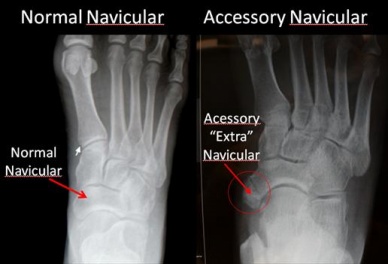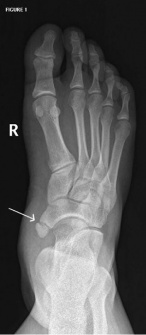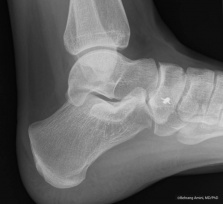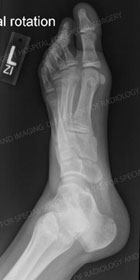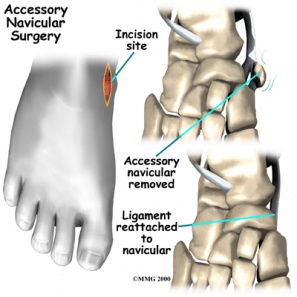Accessory Navicular Bone
Original Editors - Carlos De Coster
Lead Editors - Your name will be added here if you are a lead editor on this page. Read more.
Search Strategy[edit | edit source]
PubMed (http://www.ncbi.nlm.nih.gov/pubmed)
MeSH terms:
• Complications
• Diagnosis
• Drug therapy
• Epidemiology
• Etiology
• Pathology
• Rehabilitation
• Surgery
• Therapy
Medline Plus
Used keyword:
• Accesory navicular bone
• Os tibiale externum
Definition/Descrition
[edit | edit source]
Also known as Prehallux, Os Tibiale Externum and Navicular Secundum. When there occurs plantar medial enlargement of tarsal navicular beyond its normal size it is termed as accessory navicular. There occurs a separate bone either in the posterior tibial tendon or with navicular as a true articulation.[1]
ITS CLASSIFICATION:
It is broadly classified in 3 types
Type I: is sesamoid bone in the posterior tibialis tendon. There is a small distance (<3m) between the sesamoid and the navicular.
File:Type I AN dia.PNG File:TYPE I AN X RAY.jpg
Type II: consists of an accessory bone, upto 1.2cm in diameter, in which a synchondrosis exist between it and the navicular.
File:Type II AN.PNG File:TypeIIAccessoryNavicular.jpg
Type III: is the fused accessory navicular to the navicular resulting in large cornuate navicular.
File:TYPE III AN.PNG File:TYPE III ACCESSORY N. X RAY.PNG
ANOTHER CLASSIFICATION PURPOSED BY DWIGHT 1920 Cite error: Invalid <ref> tag; name cannot be a simple integer. Use a descriptive title
File:Accessory navicular clsfctn by Dwight.PNG
Clinically Relevant Anatomy[edit | edit source]
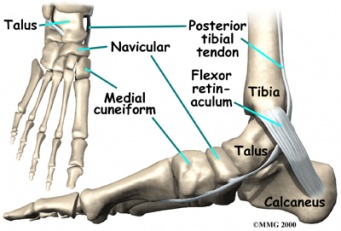 File:Foot accessory navicular clinical antomy 2.jpg
File:Foot accessory navicular clinical antomy 2.jpg
Navicular (boat shaped) is an intermediate tarsal bone on the medial side of the foot.Cite error: Invalid <ref> tag; name cannot be a simple integer. Use a descriptive title It is located on the medial side of the foot, and articulates proximally with the talus. Distally it articulates with the three cuneiform bones. In some cases it articulates laterally with the cuboid. The tibialis posterior inserts to the os naviculare.Cite error: Invalid <ref> tag; name cannot be a simple integer. Use a descriptive title The tibialis posterior muscle also contracts to produce inversion of the foot and assists in the plantar flexion of the foot at the ankle. Tibialis posterior also has a major role in supporting the medial arch of the foot. Cite error: Invalid <ref> tag; name cannot be a simple integer. Use a descriptive title This supports is compromised by abnormal insertion of the tendon into the accessory navicular bone when present. Cite error: Invalid <ref> tag; name cannot be a simple integer. Use a descriptive title Cite error: Invalid <ref> tag; name cannot be a simple integer. Use a descriptive titleThis lead to loss of suspension of tibialis posterior tendon and may cause peroneal spastic pes planus or simple pes planus. But, yet a cause and effect relationship between the accessory navicular and pes planus is doubtful and is yet unproved clearly.Cite error: Invalid <ref> tag; name cannot be a simple integer. Use a descriptive title
The presence of accessory navicular 2 or 3 is also a cause of PTT tendinopathy as the insertion of PTT on accessory navicular leads to its proximal insertion (dashed line). Here by the leverage of malleolus on the PTT is reduced and therefore stress on the tendon increase. Cite error: Invalid <ref> tag; name cannot be a simple integer. Use a descriptive title
There also occurs calcaneal pitch angle lowering in patients with with symptomatic accessory navicular than in normal subjects.Cite error: Invalid <ref> tag; name cannot be a simple integer. Use a descriptive title
Epidemiology /Etiology[edit | edit source]
The foot and ankle have numerous accessory ossification centres. But the most comman is accessory tarsal navicular bone occurring between 4-14% of population. Cite error: Invalid <ref> tag; name cannot be a simple integer. Use a descriptive titleCite error: Invalid <ref> tag; name cannot be a simple integer. Use a descriptive titleCite error: Invalid <ref> tag; name cannot be a simple integer. Use a descriptive title In children its incidence is 4-21% of the population.Cite error: Invalid <ref> tag; name cannot be a simple integer. Use a descriptive title It is frequently bilateral and occurs more commonly in women.
Three possible causes seen for the accessory navicular to occur are Cite error: Invalid <ref> tag; name cannot be a simple integer. Use a descriptive title
• Presence of bone with in posterior tibialis tendon as a sesamoind bone
• Bone having a true articulation (synovial joint) with navicular
• A synchondrosis
It is seen that accessory navicular is inherited as and autosomal dominant trait.
People who have an accessory navicular often are unaware of the condition if it causes no problems. However, some people with this extra bone develop a painful condition known as accessory navicular syndrome when the bone and/or posterior tibial tendon are aggravated. This can result from any of the following:
• Trauma, as in a foot or ankle sprain
• Chronic irritation from shoes or other footwear rubbing against the extra bone
• Excessive activity or overuse
Many people with accessory navicular syndrome also have flat feet (fallen arches). Having a flat foot puts more strain on the posterior tibial tendon, which can produce inflammation or irritation of the accessory navicular.
Characteristics/Clinical Presentation[edit | edit source]
• Typical young female (10-20 years of age) complaining of mid food/arch pain which may be insidious or post trauma.
• Difficulty with footwears.
• Prominent navicular
• Tenderness over the prominence
• Pain over the posterior tibialis tendon from a tendinitis and tightness of the tendo-achillis in long standing cases.
• Often pes planus.
• Inflamed bursa.
Differential Diagnosis[edit | edit source]
• Stress fracture Cite error: Invalid <ref> tag; name cannot be a simple integer. Use a descriptive title
• Tendinitis
• Cornuate navicular bone : elongated navicular bone.Cite error: Invalid <ref> tag; name cannot be a simple integer. Use a descriptive title
• Os tibiale externum :normal sesamoind. Cite error: Invalid <ref> tag; name cannot be a simple integer. Use a descriptive title
• Medial tuberosity fracture: best seen on CT. Cite error: Invalid <ref> tag; name cannot be a simple integer. Use a descriptive title
• Cartilage forming bone Tumor
• Kohler’s disease. Cite error: Invalid <ref> tag; name cannot be a simple integer. Use a descriptive title
Diagnostic Procedures[edit | edit source]
• Routine standing AP and lateral view are enough to look for accessory navicular but in some cases oblique view is also obtained in order to completely define the abnormality of navicular. Bilateral films may be indicated as there occurs high incidence of symmetrical abnormalities.
• On lateral weight bearing/standing film, the talonavicular cuneiform first metatarsal dorsal lalignment should be clearfully examined. “Sag” at this joint indicates structural integrity of the area. (19)
• In some cases the pronation of entire forefoot on weight bearing, as seen in the weigth bearing sesamoind view is of interest.(1)
• MRI or CT is indicated (very rare) in order to exclude tumor, fracture of medial tubersity, bone marrow edema.
AP Veiw' Lateral Veiw 'Oblique Veiw
Outcome Measures[edit | edit source]
add links to outcome measures here (also see Outcome Measures Database)
Examination[edit | edit source]
Patient with accessory navicular may present with complex pain patterns requiring thorough examination. (17) The examination importantly includes
• Differentiation of navicular prominence form talar head prominence in flat foot deformity by inverting and everting through the subtalar joint with a thumb over the bony prominence.(1,18)
• Recognition of the loss of structural integrity of the longitudinal arch is important because this component of the deformity will not be corrected by surgical treatment if required. (19)
• Thought examination of gait.
Management[edit | edit source]
CONSERVATIVE :
• Depending upon the severity the non operative or conservative treatment should be maintained for atleast 4- 6 months before any surgical intervention.(1) This includes
• Physical therapy managment of the foot.
. Medications. Oral nonsteroidal anti-inflammatory drugs (NSAIDs), such as ibuprofen, may be prescribed. In some cases, oral or injected steroid medications may be used in combination with immobilization to reduce pain and inflammation. (29)
• Corticosteroid injections can be used as a treatment modality. However, this modality should be used with caution as it may weaken the posterior tibial tendon and lead to subsequent rupture.
SURGICAL:
There are 2 surgeries that can be performed depending upon the condition and symptoms
FIRST is simple surgical excision. In this generally the accessory navicular along with its prominence is removed. In this procedure, skin incision is made dorsally to the prominence of accessory navicular. Bone is removed to the point where the medial foot has no bony prominence over the navicular, between the head of the talus and first cuneiform. Symptoms are relieved in 90% of cases. (6,7,13, 14, 17, 18, 20-27)
SECOND is Kindler procedure. (6, 7) In this the ossicle and navicular prominence is excised as in simple excision but along with the posterior tibial tendon advancement. Posterior tibial tendon is split and advanced along the medial side of foot to provide support to longitudinal arch.
After surgery 4 week short leg cast, well moulded into the arch with the foot plantigrade is applied. Partial weight bearing till the 8th week and later full weight bearing is allowed. (6, 7, 19). When the cast is being removed can start building up the ROM to counter atrophy and other physical therapy treatment which include stretching and strengthening exercises. (28)
File:CAST MOULDING.jpg File:SHORT LEG CAST.jpg
• Occasionally, a limited fusion of the cuneiform metatarsal or talonavicular joints also was recommended. The rationale and efficacy of this operation have been questioned.
• Arthrodesis may be a reasonable treatment option in selected cases of patients with symptomatic recalcitrant Type II accessory naviculars that are large enough to accept small fragment screws.(31)
Physical Therapy Management
[edit | edit source]
If the accessory navicular bone becomes problematic physical therapy may be prescribed.
This will include use of therapeutic modalities which relieves pain include ultrasonic therapy, TENS, massage,ROM exercises and treatments to strengthen the intrinsic foot muscles and lateral thigh rotators muscles and decrease inflammation. Often is the accessory navicular bone linked to Posterior tibial dysfunction to a pes planus. 9 To adjust the arch of the foot, orthotic devices are required.
• A short leg walking cast for 3 weeks in severe cases. It decrease stress on posterior tibial insertion on accessory navicular. (1)When the cast is being removed it the physician can start building up the ROM from the patient and counter atrophy. (28)
• Followed by, well padded shoe orthotic should be worn for arch support. This decrease direct pressure over the navicular. (1)
• Stretching of pernoneal and posterior tibialis along with strengthening exericises.
• Strengthening the intrinsic foot muscles and lateral thigh rotators muscles and decrease inflammation. (9)
• Activity modification, such as limiting or stopping any strenuous activities that cause the Accessory Navicular bone to become symptomatic can be used for initial treatment. (1,9)
• Gait training and Balance exercise for proper normal gait when required.
Key Research[edit | edit source]
add links and reviews of high quality evidence here (case studies should be added on new pages using the case study template)
[edit | edit source]
Resources
[edit | edit source]
Foot health facts: http://www.footphysicians.com
http://www.aofas.org/Pages/Home.aspx
Clinical Bottom Line[edit | edit source]
Usaully the type I accessory navicular is rarely associated with symptoms and if the symptoms appears then it respond well to the conservative/ physical therapy managment. Patients with Type II accessory navicular are at the risk for disruption either from traction injury or shear forces in the region and and mostly the onset is insidious or post trauma. It fails to respond to conservative treatment when severe and fusion of the accessory navicular to the navicular may successfully relieve pain without disrupting the tibialis posterior tendon insertion. (32)
Type III when symptomatic then excising the accessory navicular rather than excising navicular beak is more helpful. (19)
Recent Related Research (from Pubmed)[edit | edit source]
see tutorial on Adding PubMed Feed
Failed to load RSS feed from http://www.ncbi.nlm.nih.gov/pubmed?term=ACCESSORY%20NAVICULAR%20BONE#!!|charset=UTF-8|short|max=10: Error parsing XML for RSS
References[edit | edit source]
see adding references tutorial.
- ↑ Raymond T., Morrissy and Stuart L.Weinstein .Lovell & Winter’s Padiatric Orthopaedics. United States: Lippincot William’s & Wilkin Publication, 2005.
Raymond T., Morrissy and Stuart L.Weinstein .Lovell & Winter’s Padiatric Orthopaedics. United States: Lippincot William’s & Wilkin Publication, 2005.
Zachary C. Leonard, Paul T. Fortin, Adolescent Accessory Navicular. Foot Ankle Clin N Am 15 (2010) 337–347
1. Raymond T., Morrissy and Stuart L.Weinstein .Lovell & Winter’s Padiatric Orthopaedics. United States: Lippincot William’s & Wilkin Publication, 2005.
2. Zachary C. Leonard, Paul T. Fortin, Adolescent Accessory Navicular. Foot Ankle Clin N Am 15 (2010) 337–347
3. D.Richard, V.Wayne, M. Adam,Gray’s Anatomy for Students. Spain: Elsevier Publishers, 2005.
4. Golano P., ‘The anatomy of the navicular and periarticular structures.’ Foot Ankle Clinics, 2004, March, vol. 9, p. 1-23.
5. Kiter E., Erdan N., Karatosun V., Gunall I., ‘Tibialis posterior tendon abnormalities in feet with accessory navicular bone and flatfoot’. Acta orthopaedica Scandinavia, 1999, December, vol. 70, p. 618-621
6. Kulkarni. G.S. Textbook of orthopedics and trauma.India: Jaypee Brother Publication, 1999.
7. Kidner FC. The prehallux (accessory scaphoid) in its relation to flat-foot. J Bone Joint Surg 1929 : II : 831
8. Kidner FC. Pre-hallux in relation to flatfoot. JAMA 1933; 101: 1539-42.
9. A. Bernaerts, F.M. Vanhoenacker, S. Van de Perre, A.M. De Schepper, P.M. Parizel1 Accessory navicular bone: Not Such a normal variant. JBR–BTR, 2004, 87 (5) page 250-252
10. Prichausuk S, Sinphurmsukskul O: Kinder Procedure for symptomatic accessory navicular and its relation to pes planus, Foot Ankle 16:500,1995
11. Harris RI. Army foot survey: an investigation of foot ailments in Canadian soldiers. National Research Council of Canada, 1947
12. Shands AR Jr, Wentz IJ. Congenital anomalies, accessory bones and osteochondritis in the feet of 850 children. Surg.Clin.North Am 1953:97:1643-1666.
13. Geist ES. The accessory scaphoid bone. J Bone Joint Surg Am 1925; 7:570.
14. McKusick VA. Mendelian inheritance in man: catalogs of autosomal dominant, autosomal recessive and X-linked phenotypes, 2nd ed. Baltimore, MD: The Johns Hopkins University Press, 1968.
15. Jamshid Tehranzadeh; Musculoskeletal Imaging; page 680; Ed.2009
16. Helen Carty, Donald Shaw, Francis Brunelle, Brain Kendall; Imaging in Children; Churchill Livingston publication. Vol.2; pg no.866.
17. Ray S, Goldberg VM. Surgical treatment of the accessory navicular. Clin. Orthop 1983;177: 61-66.
18. Sullivan JA, Miller WA. The relationship of the accessory navicular to the development of the flat foot. Clin Orthop 1979; 144: 233-237.
19. S.Terry Canale, James S. Beaty,Campbell Operative Orthopaedics. United States: Mosby Publication.2008.
20. Leonard MH, Gonzalez S, Breck LW, et al. Lateral transfer of the posterior tibial tendon in certain selected cases of pes plano valgus ( Kinder Operation). Clin Orthop 1965;40: 139-144.
21. Zadek I, Gold A. The accessory tarsal scaphoid. J Bone Joint Surg Am 1948; 30A: 957.
22. Grogan DP, Gasser SI, Ogden JA. The painful accessory navicular: a clinical and histopathological study. Foot Ankle 1989; 10: 164-169. 23. Jones RL. The human foot: an experimental study of its muscles and ligaments in the support of the arch. Am J Anat 1941; 68: 1.
24. Bennett GL, Weiner DS, Leighey B. Surgical treatment of symptomatic accessory tarsal navicular. J Pediatr Orthop 1990; 10: 445-449. 25. Macnicol MF, Voutsinas S. Surgical treatment of the symptomatic accessory navicular. J Bone Joint Surg Br 1984; 66: 218-226.
26. Veitch JM. Evaluation of the Kinder procedure in treatment of symptomatic accessory tarsal scaphoid. Clin Orthop 1978; 131: 210-213. 27. Giannestrus NJ. Foot disorders: medical and surgical management. Philadelphia, PA: Lea & Febiger, 1973.
28. Leonard Z. C., Fortin P. T., ‘Adolescent accessory navicular bone’ Foot Ankle Clinics, 2010, vol. 15, p. 337-347.
29. Macnicol M. F., Voutsinass, ‘Surgical treatment of the symptomatic accessory navicular’, The Journal of Bone and Joint Surgery, 1984, vol. 66, p. 218-226.
30. Yeung- Jen C., Wen- Wei R., Liang S., ‘Degeneration of the accessory navicular synchondrosis presenting as rupture of the posterior tibial tendon’. The Journal of Bone and Joint Surgery., 1997, vol. 79, p. 1791-179.
31. Scott AT.,Sabesan VJ, Saluta JR, Wilson MA, Easley ME.Fusion versus excision of the symptomatic Type II accessory navicular: a prospective study.Foot Ankle Int. 2009 Jan;30(1):10-5.
32. Chung JW, Chu IT.,Outcome of fusion of a painful accessory navicular to the primary navicular. Foot Ankle Int. 2009 Feb;30(2):106-9.
